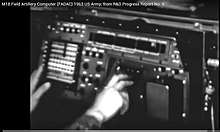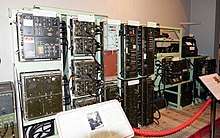Gun data computer
The gun data computer was a series of artillery computers used by the U.S. Army for coastal artillery, field artillery and anti-aircraft artillery applications. In antiaircraft applications they were used in conjunction with a director.
Variations


- M1: This was used by seacoast artillery for major-caliber seacoast guns. It computed continuous firing data for a battery of two guns that were separated by not more than 1,000 feet (300 m). It utilised the same type of input data furnished by a range section with the then-current (1940) types of position-finding and fire-control equipment.
- M3: This was used in conjunction with the M9 and M10 directors to compute all required firing data, i.e. azimuth, elevation and fuze time. The computations were made continuously, so that the gun was at all times correctly pointed and the fuze correctly timed for firing at any instant. The computer was mounted in the M13 or M14 director trailer.
- M4: This was identical to the M3 except for some mechanisms and parts which were altered to allow for different ammunition being used.
- M8: This was an electronic computer (using vacuum tube technology) built by Bell Labs and used by coast artillery with medium-caliber guns (up to 8 inches or 200 millimetres). It made the following corrections: wind, drift, earth's rotation, muzzle velocity, air density, height of site and spot corrections.
- M9: This was identical to the M8 except for some mechanisms and parts which were altered to accommodate anti-aircraft ammunition and guns.
- M10: A ballistics computer, part of the M38 fire control system, for the Skysweeper.
- M13: A ballistics computer for the M48 tank.
- M14: A ballistics computer for the M103 heavy tank.
- M15: A part of the M35 field artillery fire-control system, which included the M1 gunnery officer console and M27 power supply.
- M16: A ballistics computer for the M60A1 tank.
- M18: FADAC (Field Artillery Digital Automatic Computer),[1][2] an all-transistorized general-purpose digital computer[3] manufactured by Amelco (Teledyne Systems, Inc.,)[4] and North American—Autonetics.[5] FADAC was first fielded in 1960,[6][7] and was the first semiconductor-based digital electronics field-artillery computer.
- M19: A ballistics computer for the M60A2 tank.
- M21: A ballistics computer for the M60A3 tank.
- M23: A mortar ballistics computer
- M26: A fire-control computer for the AH-1 Cobra, (AH-1F).
- M31: A mortar ballistics computer.
- M32: A mortar ballistics computer, (handheld).
- M1: A ballistics computer for the M1 Abrams main battle tank
Systems

- The Battery Computer System (BCS) AN/GYK-29 was a computer used by the United States Army for computing artillery fire mission data. It replaced the Field Artillery Digital Automatic Computer (FADAC) and was small enough to fit aboard the HMMWV combat platform.
- The AN/GSG-10 TACFIRE system automated Field Artillery command and control functions. It was composed of computers and remote devices such as the Variable Format Message Entry Device (VFMED), the Digital Message Device (DMD) and the Firefinder Field Artillery target acquisition radar system linked by digital communications using existing radio and wire communications equipment. Later in its service life, it also linked with the Battery Computer System (BCS) which had more advanced targeting algorithms.
The last TACFIRE fielding was completed in 1987. Replacement of TACFIRE equipment began in 1994.
TACFIRE used the AN/GYK-12, a second-generation mainframe computer developed primarily by Litton Industries for Army Divisional Field Artillery (DIVARTY) units. It had two configurations, division and battalion level, housed in mobile command shelters. Field Artillery Brigades also use the division configuration.
Components of the system were identified using acronyms:
- CPU (central processing unit)
- IOU (input/output unit)
- MCMU (mass core memory unit)
- DDT (digital data terminal)
- MTU (magnetic tape unit)
- PCG (power converter group)
- ELP (electronic line printer)
- DPM( digital plotter map)
- ACC (artillery control console)
- RCMU (remote control monitoring unit)
The successor to the TACFIRE system is the Advanced Field Artillery Tactical Data System (AFATDS).
- The AFATDS is the "Fires XXI" computer system for both tactical and technical fire control. It replaced both BCS (for technical fire solutions) and IFSAS/L-TACFIRE (for tactical fire control) systems in U.S. Field Artillery organizations, as well as in maneuver fire support elements at the battalion level and higher. As of 2009, the U.S. Army was transitioning from a version based on a Sun Microsystems SPARC computer running the Linux kernel to a version based on laptop computers running the Microsoft Windows operating system.
Surviving examples
One reason for a lack of surviving examples of early units was the use of radium on the dials, which officially made them hazardous waste, and as such were disposed of by the United States Department of Energy. Currently there is one surviving example of FADAC at the Fort Sill artillery museum.[8]
See also
- Director (military)
- Fire-control system
- Kerrison Predictor
- Mark I Fire Control Computer - US Navy system for 5-inch guns
- Numerical control
- Project Manager Battle Command
- Rangekeeper
References
- Kempf, Karl (November 1961). "CHAPTER VI -- COMPUTERS FOR SOLVING GUNNERY PROBLEMS". Electronic Computers Within The Ordnance Corps, Computers for Solving Gunnery Problems.
- "Field Artillery Digital Automatic Computer (FADAC)". Department of Defense Appropriations for 1970, Part 5. Hearings 91st Congress 1st Session 1969. HathiTrust. 9: 644–645, 647–648.
- Lieutenant Albert R. Milavec. "On FADAC Maintenance". p. 32 of "Artillery Trends" May 1968. "The FADAC is an all-transistorized, stored-program, general purpose digital computer ... Weighing approximately 200 pounds ... the FADAC components utilize approximately 1,600 transistors, 9,000 diodes, 6,000 resistors, 500 capacitors, and many other switches, transformers, and neon lamps."
- Department of Defense appropriations for 1965, pt.3, p. 283.
- "Field Artillery Digital Automatic Computer". p. 254 of Martin H. Weik. "A Third Survey of Domestic Electronic Digital Computing Systems". 1961.
- Datamation. F.D. Thompson Publications. January 1964. p. 61.
- "The United States Army | Fires Bulletin". sill-www.army.mil. "First Round Hits" With FADAC. September 1960. p. 9. Retrieved 2018-03-09.CS1 maint: others (link)
- "U.S. Army Field Artillery Museum - Home".
- TM 9-2300 Standard Artillery and Fire Control Materiel dated 1944
- TM 9-2300 Artillery Materiel and Associated Equipment. dated May 1949
- ST 9-159 Handbook of Ordnance materiel dated 1968
- Gun Data Computers, Coast Artillery Journal March–April 1946, pp. 45–47
External links
- http://www.globalsecurity.org/military/library/report/1988/MJR.htm
- http://ed-thelen.org/comp-hist/BRL61.html#TOC
- modern system
- https://web.archive.org/web/20110617062042/http://sill-www.army.mil/famag/1960/sep_1960/SEP_1960_PAGES_8_15.pdf
- http://oai.dtic.mil/oai/oai?verb=getRecord&metadataPrefix=html&identifier=AD0491173
- https://web.archive.org/web/20040511174351/http://combatindex.com/mil_docs/pdf/hdbk/0700/MIL-HDBK-799.pdf
- https://web.archive.org/web/20110720002347/https://rdl.train.army.mil/soldierPortal/atia/adlsc/view/public/12288-1/FM/3-22.91/chap1.htm
- https://web.archive.org/web/20110617062233/http://sill-www.army.mil/famag/1958/FEB_1958/FEB_1958_PAGES_32_35.pdf
- Bell labs patent
- http://web.mit.edu/STS.035/www/PDFs/Newell.pdf
- tacfire Archived at
- BCS components